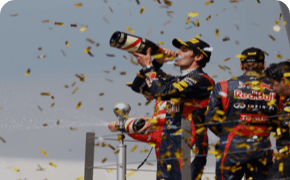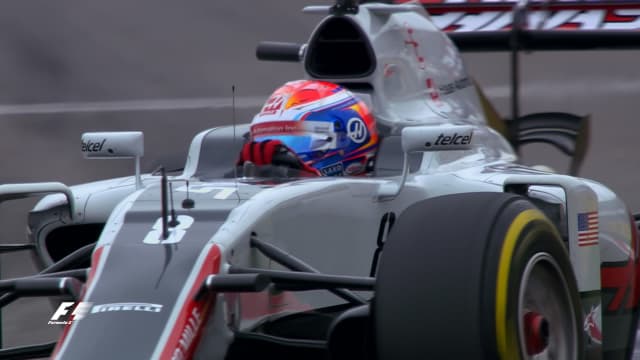Q: Two Grands Prix for Haas F1 Team, two very strong races for Haas F1 Team. Did you think this kind of success would be possible this soon?
Guenther Steiner: No, not realistically. We always said we would like to score points and make a difference. We wanted to be midfield, but to finish sixth and fifth in our first two races was, for sure, not in the plan. But, we take it and we are very happy about it.
Q: During each Grand Prix race weekend, you learn more about the car. But what are you learning about tyre strategy and how the different tyre compounds affect the car in different ways?
GS: It’s always Grand Prix-specific. You go out and test on Friday and Saturday and you learn tyre degradation, mainly, and grip levels. I think in Australia we used the data we gained in Barcelona because we didn’t run a lot in Australia due to the weather. Every race is different and every track is different. Each tyre reacts differently with the track and we always try to learn as much as possible during the race weekend. But again, we have to choose the tyres before the race weekend. Our team has made good decisions and picked the right tyres, for the right time, for each race weekend.
Q: With the qualifying format used in Australia and Bahrain, how advantageous was it to make it to Q2 but not Q3?
GS: In Australia, we were far from making Q2 because we had some issues in Q1. In Bahrain, we were very happy not to be in Q3 because it allowed us to start the race on a brand new set of tyres. With brand new tyres, you see a lot more grip on the start. Both drivers took that to their advantage and had very good starts.
Q: For the first time in Haas F1 Team’s young history, both drivers advanced to the second round of qualifying. How important was that for the team?
GS: Advancing to Q2 really helped our confidence. We wanted to show that in Australia and couldn’t, but we did in Bahrain and this is what we will try to achieve every race weekend.
Q: Haas F1 Team has begun its debut season by surpassing expectations. But how hard is it to stay ahead of the curve in Formula One, as everyone is constantly developing their car?
GS: It is very difficult, but we will continue to develop. We’ll continue to test in the wind tunnel and bring new developments to our car, and that will lead to gains in our aerodynamic program throughout the season. I think we’ll bring new developments like the rest of the midfield packs are doing, or aiming to do.
Q: Bahrain saw the team’s first live pit stops. How were they, and how does it feel to finally have performed live pit stops?
GS: I would say two out of the three pit stops were good. We still can improve, but we were in the ballpark. In the third one we had an issue with one of the wheel nuts. I give credit to the crew member because when he went to put the wheel on, he realized something was wrong and took it off again. Had he not fixed it, the car probably would have been stopped after the first two corners from the wheel being loose. So we had an issue, but we solved it and maybe lost two seconds and it didn’t make a difference anyway. The mechanic and his actions stopped us from making an even bigger mistake.
Q: While the team is performing well and Grosjean has the results to prove it, bad luck has hampered Gutierrez’s efforts and he’s had back-to-back retirements. How do you balance the success of one driver while working to help the other driver overcome the adversity he’s faced?
GS: With Esteban’s incident in Australia, you look at it with the mind set of, ‘What can you do when a guy runs into you?’ In Bahrain, we had an issue with his brake disc and are still investigating why it actually broke. We are working with the brake manufacturer to have a better understanding of the issue and avoid it in the future. I spoke with Esteban after the race and he said, ‘Guenther, these things happen. There’s nothing we can do.’ He understands why he’s had to retire from each race and now he’s more determined to get to the end and earn points.
Q: Explain the level of sophistication with today’s Formula One car. Why can’t a problem be fixed in the garage during the race in the same manner a problem with a NASCAR Sprint Cup Series car can be fixed during the race?
GS: If something breaks in a Formula One car, they are so highly sophisticated that it’s quite a process to determine all that’s wrong and then, normally, there’s not enough time to fix it. Plus, your mechanics are involved in all the pit stops, so when something goes wrong, you can’t pull three or four guys to fix an issue because, by regulation, they’re needed for the pit stop with the other car that’s still running on the racetrack. To try to fix the car just to come in last, 20 laps down, doesn’t make any sense.
Q: Two races in and you’ve already reached some preseason goals, namely scoring points. What do you want to achieve in China?
GS: One of our goals is to take two cars to the finish, because we haven’t done that one yet. You always want to get better, and the next thing for us to do is take two cars to the finish and, hopefully, both score points.



















